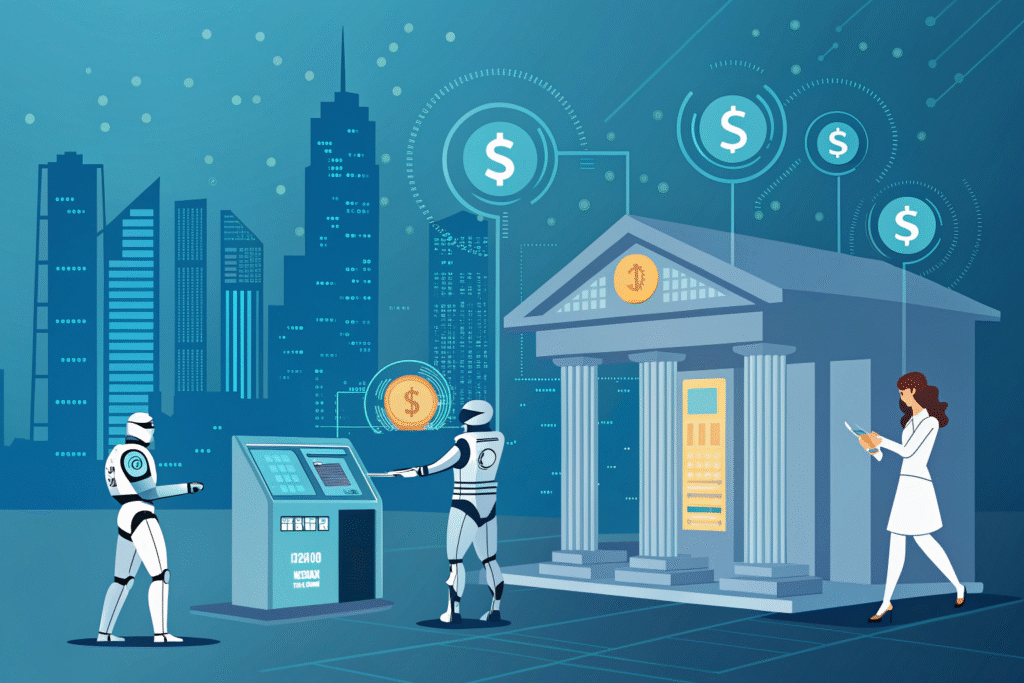
The worlds of finance and banking, long defined by tradition and human analysis, are undergoing a seismic shift. Artificial Intelligence (AI) is no longer a futuristic concept; it’s a powerful, present-day force driving efficiency, security, and unprecedented personalization. For entrepreneurs, marketers, and content creators, understanding this transformation is crucial. It’s not just about algorithms replacing tasks; it’s about creating new business models, enhancing customer experiences, and unlocking value in vast datasets. This article delves into the journey of AI in finance, its core applications, and the immense potential it holds for the future.
Introduction: From Ledgers to Learning Machines
The integration of AI in finance marks a move from reactive to proactive systems. Where once spreadsheets and manual reviews ruled, self-learning algorithms now analyze patterns, predict trends, and automate complex decisions in real-time. This evolution is creating a more inclusive, efficient, and secure financial ecosystem for businesses and consumers alike.
History & Evolution of AI in Finance
The journey didn’t start with today’s sophisticated chatbots. It’s been a gradual progression.
- 1980s – Expert Systems: The first wave involved rule-based “expert systems” designed to emulate human decision-making for tasks like credit scoring. They were rigid but laid the groundwork.
- 1990s-2000s – Statistical Models & Automation: The rise of more complex statistical models and machine learning improved fraud detection and algorithmic trading. This era saw the automation of back-office operations.
- 2010s-Present – The Deep Learning Boom: With big data and advanced neural networks, AI exploded. Capabilities like natural language processing (NLP) enabled sentiment analysis of news for trading and powered the first intelligent virtual assistants.
Audience & Demographics: Who Benefits from AI Finance?
The impact of AI is widespread, serving a diverse range of users:
- Retail Banking Customers: Benefit from 24/7 customer service chatbots, personalized financial advice (robo-advisors), and streamlined loan applications.
- Investment Firms & Traders: Utilize AI for high-frequency trading, predictive analytics, and portfolio risk management.
- Businesses & Entrepreneurs: Leverage AI for improved cash flow forecasting, automated invoice processing, and enhanced fraud protection.
- Marketers & Content Creators: Can use AI-driven insights to understand customer segments, personalize marketing campaigns, and create targeted financial content.
Key Features & Functions Reshaping the Industry
AI’s value comes from its core functionalities. Here’s how they are applied:
Fraud Detection and Cybersecurity
AI systems analyze transaction patterns in real-time to flag anomalies that humans might miss, significantly reducing financial losses.
Algorithmic Trading
Machines execute trades at superhuman speeds based on complex market data, identifying fleeting opportunities that are invisible to the naked eye.
Personalized Banking and Robo-Advisors
AI tailors product recommendations, savings goals, and investment strategies to individual user behavior and financial goals, making wealth management accessible to the masses.
Credit Scoring and Risk Management
By analyzing alternative data (e.g., cash flow, utility payments), AI can provide credit scores for individuals with thin files, promoting financial inclusion.
Process Automation (RPA)
Robotic Process Automation handles repetitive tasks like data entry, compliance checks, and customer onboarding, freeing up human employees for more complex work.
Business & Marketing Potential
For forward-thinking professionals, the opportunities are vast:
- New Revenue Streams: Develop AI-powered financial products, such as subscription-based analytics tools for small businesses.
- Hyper-Personalized Marketing: Use AI to segment audiences with incredible precision and deliver highly relevant content and offers, boosting conversion rates.
- Enhanced Customer Loyalty: By providing proactive, helpful, and seamless experiences, businesses can build stronger, more trusting relationships with their customers.
Best Practices & Tips for Implementation
Adopting AI successfully requires a strategic approach:
- Start with a Clear Problem: Don’t adopt AI for its own sake. Identify a specific pain point, such as high fraud rates or slow customer service response times.
- Prioritize Data Quality: AI models are only as good as the data they’re trained on. Ensure your data is clean, organized, and comprehensive.
- Focus on Transparency (“Explainable AI”): Especially in regulated fields like finance, being able to explain an AI’s decision is critical for trust and compliance.
- Upskill Your Team: Invest in training for existing employees to work alongside AI tools effectively.
Challenges & Limitations
Despite its potential, AI in finance faces hurdles:
- Data Privacy and Security: Handling sensitive financial data requires robust security measures and strict adherence to regulations like GDPR.
- Algorithmic Bias: If trained on biased historical data, AI can perpetuate and even amplify discrimination in areas like lending.
- High Implementation Costs: Developing and integrating sophisticated AI systems requires significant investment in technology and expertise.
- Regulatory Uncertainty: The regulatory landscape for AI is still evolving, creating a challenging environment for innovation.
Future Outlook: What’s Next for AI in Finance?
The next decade will see even more profound changes:
- Generative AI: Will create highly personalized financial reports, simulate economic scenarios for planning, and revolutionize customer interactions.
- Explainable AI (XAI): Will become standard, making AI decisions more transparent and auditable.
- AI-Driven Hyper-Personalization: Banking experiences will become uniquely tailored to individual life events and goals in real-time.
- Decentralized Finance (DeFi): AI will play a key role in managing risk and automating processes within the blockchain-based financial ecosystem.

Conclusion: Embracing the Intelligent Future
The integration of AI in finance and banking is an unstoppable tide, fundamentally altering how we manage, invest, and interact with money. For entrepreneurs and marketers, it presents a landscape rich with opportunity for innovation, customer engagement, and growth. While challenges around ethics, regulation, and implementation remain, the potential for a more efficient, secure, and personalized financial world is undeniable. The key is to approach this transformation thoughtfully, prioritizing strategic value and human oversight to harness the full power of artificial intelligence.